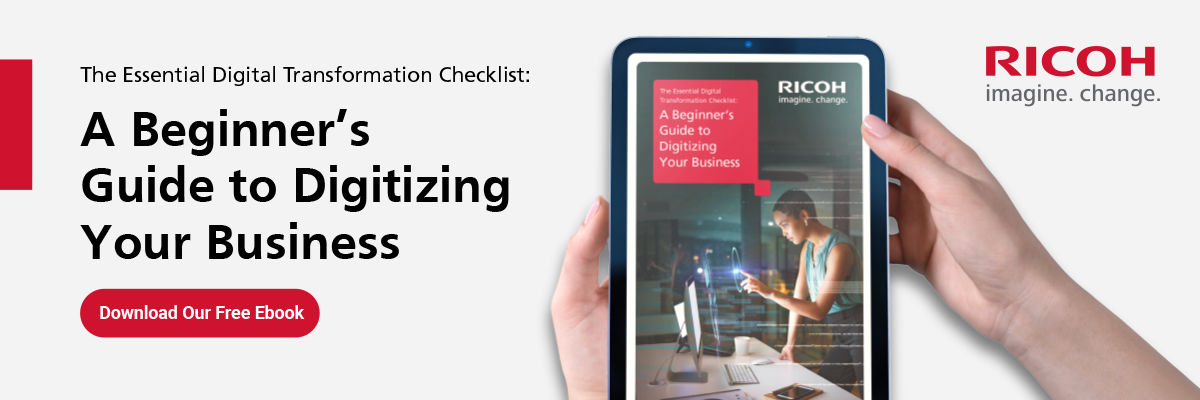Discover the fundamentals of transforming physical media into digital copies
Businesses and households alike are adopting the digital future at a rapid pace, embracing digital solutions through teleconferencing software, cloud storage, streaming media services, and more. In fact, 91% of organizations have already implemented or plan to implement a digital-first strategy. To do this, many are discovering that their physical media — like documents, images, DVDs, and CDs — needs to be converted to a digital format through a process called digitalization.
If you’re wondering, “What is digitization” and where to start, you’re in the right place. Read on to learn more about the best candidates for digitization and the many benefits of digitizing your physical media.
Want to learn more about how digitization can improve office productivity? Check out our guide, The Complete Guide to Digitization for more information.
What is digitization?
Gartner offers a definition of digitization as the process of converting physical assets into a digital, computer-readable format. The computer stores these digital assets as a series of bits and bytes — or 0s and 1s in binary — which the operating system then translates into human-readable formats.
Digitization typically requires external hardware, like a document scanner, DVD player, or other input devices. These devices, sometimes used alongside specialized software, can read physical media and convert them into formats the computer can access.
Once stored on a computer, these digital assets can be easily accessed via an appropriate application or shared with others via email or social media.
Digitization vs. digitalization
When we define digitization, we’re specifically referring to the act of conversion from physical to digital media.
Digitalization, on the other hand, refers to how organizations build digital-forward processes that encompass the entire workflow. According to Gartner, digitalization is “the use of digital technologies to change a business model and provide new revenue and value-producing opportunities; it is the process of moving to a digital business.”
Converting physical documents into digital assets is part of an overall digitalization strategy, but it’s not the only thing. Organizations may also reduce overall paper use within the business and encourage customer messaging through email or digital platforms rather than physical mail.
This larger digital transformation is the most important difference when comparing digitalization vs. digitization. It takes digitization to create a truly digitalized work environment.
What type of assets can I digitize?
Print media and documents
When examining the meaning of digitization, backing up photos, media and documents is likely the first example that comes to mind. Document scanners are vital accessories for businesses and households that want to back up important photos, tax and budgetary paperwork, or archive old documents for safekeeping.
Scanners come in various formats, like flatbed scanners that allow for single-page processing and are perfect for thicker or more fragile documents, or sheet-fed scanners, which can process hundreds of scans within minutes. Most scanners can digitize documents in color or black and white, and many can scan both sides simultaneously to increase conversion speeds.
Regardless of what you’re using, you’ll be able to make high-quality digital reproductions of many of the following:
- Papers
- Photographs
- ID Cards
- Books
- Periodicals
- Manuscripts
- Drawings
- Receipts
Did You Know?:The fi-8170 can scan up to 70 pages per minute and 10,000 pages per day. Click here to learn more.
Music CDs and vinyl records
Music collections are great for listening to tunes around the house. However, if your collection is largely physical, bringing your music with you on a long commute or road trip is difficult.
Luckily, ripping your CDs through iTunes or other software and converting the music to .mp3 files that any smartphone can play is a straightforward process. Plus, depending on your needs, you can set the encoding quality level to focus on audio quality or compression to increase storage space.
Transferring vinyl records requires special hardware, like a USB-enabled turntable. Still, once you have the appropriate tech, you can turn your record collection into audio files fairly easily.
Movies and video files
There’s no denying the immediate allure of streaming platforms like Netflix that put thousands of movies and TV shows at your fingertips. It’s much easier to queue up a movie on Netflix than to flip through your physical DVD and Blu-Ray collection.
Much like audio CDs, it’s possible to use a USB DVD or Blu-Ray player and PC software to digitize your film collection. Then, through solutions like Plex or Kodi, you can set up a home media server to make your collection as easily accessible as anything on Netflix or Hulu.
Disc-based media is the easiest to digitize, but it’s just as possible to pull memories from VHS cassette tapes to share old home movies with friends and family. VHS takes specialized equipment to digitize, and many services will provide digital backups and restoration work to enhance image quality.
What does digitization mean for my organization or home office?
Free up space and reduce clutter
Storing physical media is an effective solution for a while, but over time you’re eventually going to run out of physical space. Plus, even the best-kept assets degrade over time. Once digitized, your only limit is the amount of storage space you have available, and you can easily upgrade with internal and external hard drives, USB thumb drives, and SD cards. Or send files to the cloud to keep files organized without worrying about purchasing additional physical storage.
Easier to share
Once an asset is digitized, it can be easily shared with anyone with the capabilities to open and view the content. Virtually all PCs come equipped with the ability to view images, listen to music files, open documents, or watch videos right out of the box. Send photos via email, upload necessary documents to the cloud, share memories on Facebook, or upload old wedding videos to YouTube — the sharing possibilities are virtually endless.
Edit and enhance pre-existing documents
Modern scanners include optical character recognition (OCR) features that can convert physical text documents into fully-editable digital copies. And for artists, the entire digital media toolkit — programs like Adobe Photoshop, Final Cut Pro, or Audacity — works with digitized physical media as efficiently as digital content. Convert physical images into digital files, then dress them up however you like — or even treat them like samples and edit them into unique songs, photos, or videos.
Retrieval
Retrieving paper documents can be expensive and time consuming, sometimes leading to document loss due to misfiling. However, finding documents when they are digitized, converted to text and indexed saves time, allowing anyone to access documents when needed.
Prevent data loss
As physical media degrades over time, it’s important to create digital backups that can remain accessible in the future. Users can back up digitized files on multiple drives, physical RAID servers, or the cloud.
Did You Know?:PCMagazine described the fi-8170 as “a fast and accurate desktop scanner that’s ideal as a front end for high-powered document archiving applications.” Click here to read the full review and learn why it earned an “excellent” 4 out of 5 rating.
Our recommendation: fi and SP Series scanners
Those in the market for a digital scanner have no shortage of options. We take great pride in having spent the last 50+ years researching, designing and developing some of the most advanced and powerful electronics in the world, including our professional grade fi and SP Series scanners.
Built to purpose for the most demanding document handling jobs, the fi and SP Series scanners are capable of processing tens-of-thousands of pages per day at the highest levels of accuracy. Their intuitive integration capabilities with all existing work suites minimize time-to-value for businesses looking to invest in tools that will pay dividends for years to come. Click here to learn more or shop the rest of our production scanner line.








